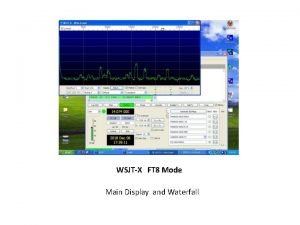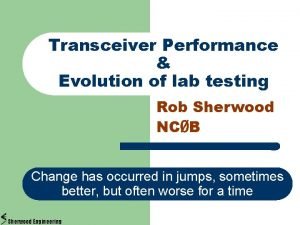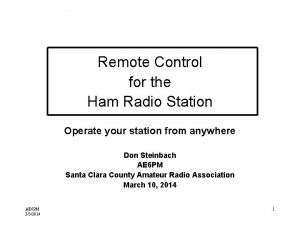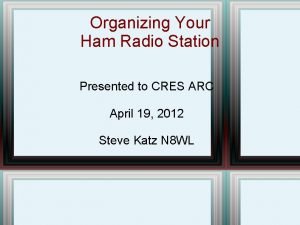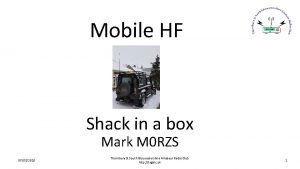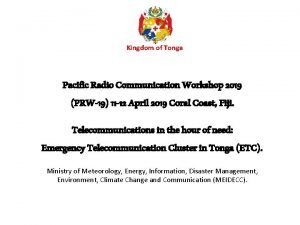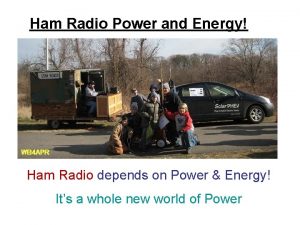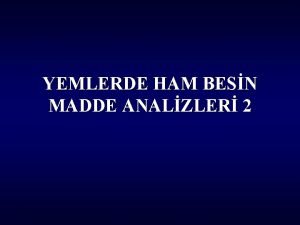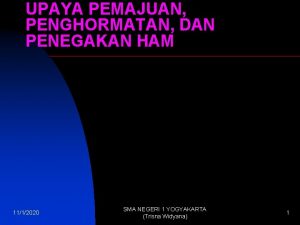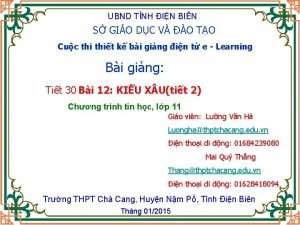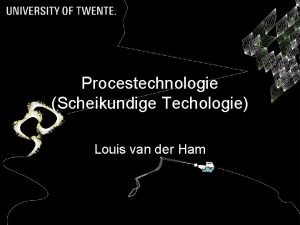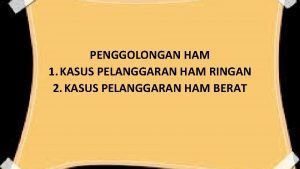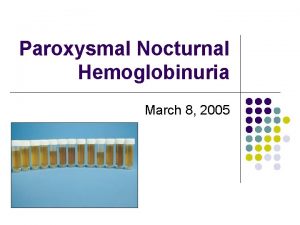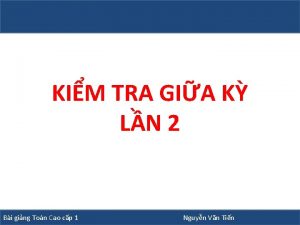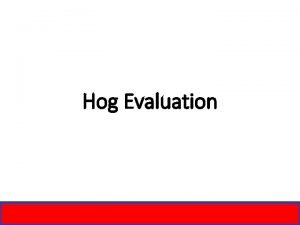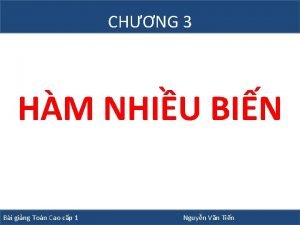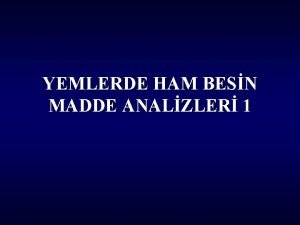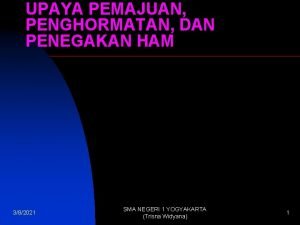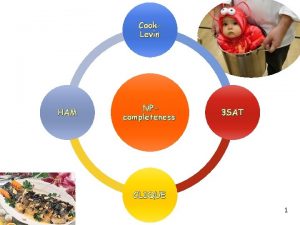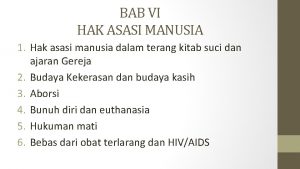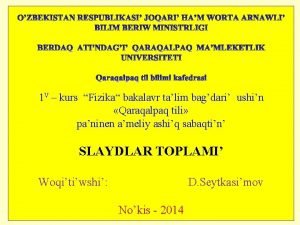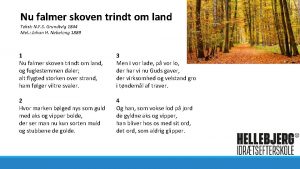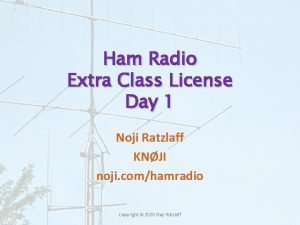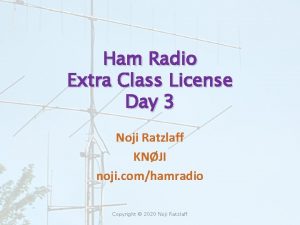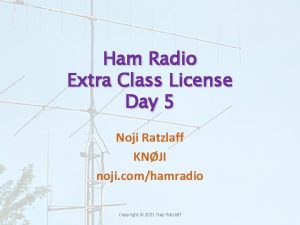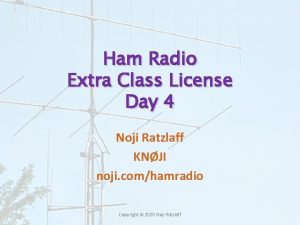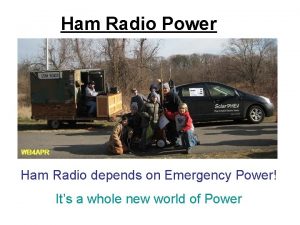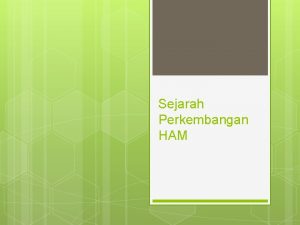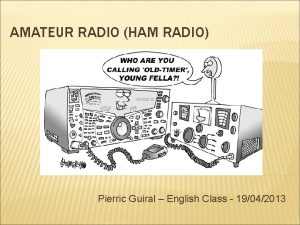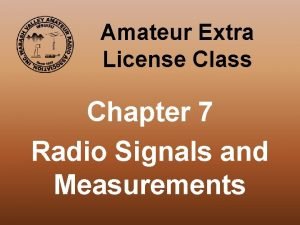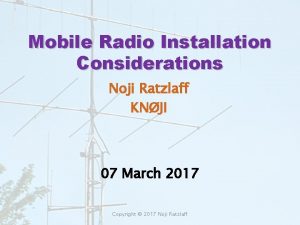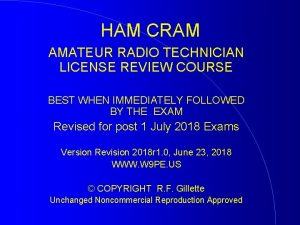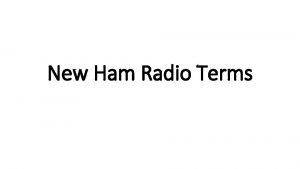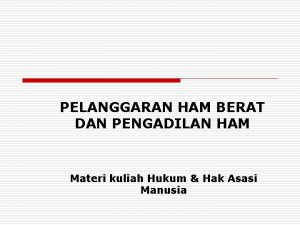Ham Radio Extra Class License Day 2 Noji




























































- Slides: 60

Ham Radio Extra Class License Day 2 Noji Ratzlaff KNØJI noji. com/hamradio Copyright © 2020 Noji Ratzlaff

Ham. Study progress Show me Copyright © 2020 Noji Ratzlaff

What we plan to accomplish today Cover • E 4 : Amateur practices • E 5 : Electrical principles Copyright © 2020 Noji Ratzlaff

E 4 : Amateur practices Noise Interference and other problems Resolving noise and interference problems Receiver performance characteristics Test equipment Measurement technique and limitations Copyright © 2020 Noji Ratzlaff

Electrical noise Alternator Can be solved by Direct battery power and coaxial (inline) capacitors Electric motor Can be solved by Brute-force AC-line filter Copyright © 2020 Noji Ratzlaff

House noise How to test for it coming from your home Turn off all AC and listen by battery Electrical wiring near an antenna picks up Common-mode signal at the RF frequency Loud roaring or buzzing AC interference Thermostat, doorbell, or advertising sign Unstable modulation at some frequencies Nearby personal computer Copyright © 2020 Noji Ratzlaff

Atmospheric noise Primary source of HF receiver noise Thunderstorms are a major cause Copyright © 2020 Noji Ratzlaff

Other noise sources Touch controlled device AC hum on an AM receiver Drifts slowly across the HF spectrum Can be several k. Hz in width Combinations of local AM broadcasts on HF bands Nearby corroded metal joints are mixing and reradiating the broadcasts Copyright © 2020 Noji Ratzlaff

Resolving noise problems DSP noise filter Reduces broadband white noise, ignition noise, and power line noise DSP on CW however Can also remove the desired signal Roofing filter Improves dynamic range by attenuating strong nearby signals Copyright © 2020 Noji Ratzlaff

Noise blanker A receiver noise blanker might be able to remove signals that appear across a wide bandwidth Ignition noise can often be reduced by use of a noise blanker Noise blanker side-effect Nearby legal signals can appear excessively wide Copyright © 2020 Noji Ratzlaff

Image interference Mirror-image of a signal around the IF Receiver with 455 k. Hz IF tuned to 14. 300 MHz might get a spurious image from 15. 210 MHz To eliminate image signal interference Front-end filter or pre-selector Why select high frequency for the IF? Easier to eliminate image responses Copyright © 2020 Noji Ratzlaff

Desensitization Reduction in receiver sensitivity caused by a strong, nearby frequency Decrease RF bandwidth to reduce the likelihood of receiver desensitization Copyright © 2020 Noji Ratzlaff

Receiver noise figure Theoretical noise floor (minimum) -174 d. Bm/Hz Noise figure Ratio of receiver noise to theoretical minimum noise For a perfect receiver with 400 Hz noise bandwidth, unmodulated carrier input is -148 d. Bm Lowering the noise figure Improves weak signal sensitivity Copyright © 2020 Noji Ratzlaff

Receiver dynamic range Difference between the smallest and largest discernible signal Blocking dynamic range Difference between the noise floor and an incoming signal that will cause 1 d. B of gain compression Poor dynamic range causes Cross-modulation Desensitization Copyright © 2020 Noji Ratzlaff

Intermodulation interference Unwanted signals generated by the mixing of two or more signals Can occur with two repeaters in close proximity and their signals mix A properly terminated circulator at the transmitter output can eliminate IMI In a circuit, IMI can be caused by nonlinear circuits or devices Copyright © 2020 Noji Ratzlaff

Intermodulation products fmod = 2 fn – f 1 = 2 f 2 – fn Given fmod = 146. 70 MHz, fn = 146. 52 MHz f 1 = 146. 34 MHz, f 2 = 146. 61 MHz A third-order intercept level of 40 d. Bm means a pair of 40 d. Bm signals will generate a thirdorder IM product with the same level Third-order IM products created within a receiver are likely also in the band Copyright © 2020 Noji Ratzlaff

Other problems Cross-modulation Heard in addition to your desired signal Capture effect Blocking one FM signal by a stronger one Copyright © 2020 Noji Ratzlaff

Receiver selectivity Desired selectivity for a RTTY receiver 300 Hz Desired selectivity for an SSB receiver 2. 4 k. Hz Too wide a filter bandwidth can cause Undesired signals to be heard MDS Minimum discernible signal Copyright © 2020 Noji Ratzlaff

Oscilloscope Used for detailed analysis of signals Be sure to keep the probe ground short Probe compensation adjusted by flattening the horizontal portions of a square wave Copyright © 2020 Noji Ratzlaff

Spectrum analyzer Displays signals in the frequency domain Horizontal axis is frequency, vertical axis is amplitude (power) Displays spurious transmitter signals Can display intermodulation distortion products for SSB Copyright © 2020 Noji Ratzlaff

Frequency counter Used for measuring frequency accurately Time base accuracy affects counter most For 146. 52 MHz and +/- 1. 0 ppm accuracy 146. 52 Hz For 146. 52 MHz and +/- 0. 1 ppm accuracy 14. 652 Hz For 146. 52 MHz and +/- 10 ppm accuracy 1465. 20 Hz Copyright © 2020 Noji Ratzlaff

E 5 : Electrical principles Impedance Plots and coordinate systems Time constants and phase relationships Reactance and resonance AC and RF energy in real circuits Reactive power Copyright © 2020 Noji Ratzlaff

Current flow In a conductor, electrons flow due to pressure from a voltage source The movement of electrons leaves “holes” for other electrons to fill Convention follows the flow of “holes” Current flows in the opposite direction of electron flow Copyright © 2020 Noji Ratzlaff

Resistors Resistance Measured in ohms (Ω) Her Drops voltage Opposes current flow without regard to frequency Copyright © 2020 Noji Ratzlaff

Resistors in series Values add Rtotal = R 1 + R 2 If R 1 = 15 Ω and R 2 = 25 Ω, then Rtotal = 40 Ω Copyright © 2020 Noji Ratzlaff

Resistors in parallel Reciprocal vales add to a reciprocol total 1/Rtotal = 1/R 1 + 1/R 2 If R 1 = 20 Ω and R 2 = 20 Ω, then Rtotal = 10 Ω Two-resistor shortcut : product over the sum 20 Ω || 30 Ω = (20 Ω X 30 Ω) / (20 Ω + 30 Ω) = 12 Ω Copyright © 2020 Noji Ratzlaff

Inductors Inductance Measured in henries (H) Opposes current change Opposition to current flow increases with frequency Copyright © 2020 Noji Ratzlaff

Inductors in series Values add Ltotal = L 1 + L 2 If L 1 = 20 m. H and L 2 = 50 m. H, then Ltotal = 70 m. H Copyright © 2020 Noji Ratzlaff

Inductors in parallel Reciprocal vales add to a reciprocol total 1/Ltotal = 1/L 1 + 1/L 2 If L 1 = 50 m. H and L 2 = 50 m. H, then Ltotal = 25 m. H Two-inductor shortcut : product over the sum 20 m. H || 30 m. H = (20 m. H X 30 m. H) / (20 m. H + 30 m. H) = 12 m. H Copyright © 2020 Noji Ratzlaff

Capacitors Capacitance Measured in farads (F) Opposes voltage change Opposition to current flow decreases with frequency Copyright © 2020 Noji Ratzlaff

Capacitors in series Reciprocal vales add to a reciprocol total 1/Ctotal = 1/C 1 + 1/C 2 If C 1 = 12 µF and C 2 = 4 µF, then Ctotal = 3 µF Two-capacitor shortcut : product over the sum 20 µF § 30 µF = (20 µF X 30 µF) / (20 µF + 30 µF) = 12 µF Copyright © 2020 Noji Ratzlaff

Capacitors in parallel Values add Ctotal = C 1 + C 2 If C 1 = 12 µF and C 2 = 4 µF, then Ctotal = 16 µF Copyright © 2020 Noji Ratzlaff

Trigonometry review The three basic trigonometric functions are ratios, with θ representing some angle SOH CAH TOA Remember that tanθ = sinθ / cosθ tan-1(o/a) = θ, sin-1(o/h) = θ, cos-1(a/h) = θ Copyright © 2020 Noji Ratzlaff

Impedance Opposition to AC current flow Z = R + j. X all units are in ohms (Ω) R = resistance X = reactance Zmag = √(R 2 + X 2) = √[R 2 + (XL – XC)2] Copyright © 2020 Noji Ratzlaff

Reactance X=X –X L C opposition to AC flow caused by inductance or capacitance XL is called inductive reactance XC is called capacitive reactance Copyright © 2020 Noji Ratzlaff

Inductive reactance X = ωL = 2πf. L (Ω) L (ω = 2πf) f = frequency (Hz) L = inductance (H) as the frequency increases, inductive reactance increases Copyright © 2020 Noji Ratzlaff

Capacitive reactance XC = 1/ωC = 1/(2πf. C) (Ω) f = frequency (Hz) C = capacitance (F) as the frequency increases, capacitive reactance decreases Copyright © 2020 Noji Ratzlaff

Rectangular coordinates Impedance Z = R + j. X Plot R versus X Real versus imaginary Copyright © 2020 Noji Ratzlaff

Calculator exercise : plot Z 1. 400 Ω, 38 p. F, 14 MHz Point 4 2. 300 Ω, 18 µH, 3. 505 MHz Point 3 3. 300 Ω, 19 p. F, 21. 200 MHz Point 1 4. 300 Ω, 0. 64 µH, 85 p. F, 24. 9 MHz Point 8 Copyright © 2020 Noji Ratzlaff

Polar coordinates Impedance Still real versus imaginary Zmag ∠θ Plot Zmag and angle Copyright © 2020 Noji Ratzlaff

Rectangular ― polar conversion Rect = R + j. X Polar = Zmag ∠θ, where Zmag = √(R 2 + X 2) and θ = tan-1(X/R) for series circuits Zmag = RX/√(R 2 + X 2) and θ = tan-1(R/X) for parallel circuits Rect = Zmagcosθ + j. Zmagsinθ Example: put Z = 100 + j 100 Ω in polar 141∠ 45° Ω Copyright © 2020 Noji Ratzlaff

Admittance Y = 1/Z = G + j. B Inverse of impedance Measured in siemens (S) Z is impedance (Ω) Y is admittance (S) G is conductance (S) B is susceptance (S) Copyright © 2020 Noji Ratzlaff

Resonance XL = XC Z = R + j. X = R + j(XL – XC) =R But at what frequency? Series RLC : input current at maximum voltages can be larger than the applied Parallel RLC : input current at minimum circulating current is at maximum Copyright © 2020 Noji Ratzlaff

Voltage and current in-phase Purely resistive Plot Z = R Copyright © 2020 Noji Ratzlaff

Inductor voltage leads current Inductor : voltage leads the current (current lags the voltage) 90° out of phase Copyright © 2020 Noji Ratzlaff

Capacitor current leads voltage Capacitor : current leads the voltage (voltage lags the current) 90° out of phase Copyright © 2020 Noji Ratzlaff

ELI the ICE man EL I : voltage leads the inductor current lags the voltage ICE : current leads the capacitor voltage lags the current Copyright © 2020 Noji Ratzlaff

Series RLC calculation quiz R = 1 kΩ XL = 250 Ω XC = 500 Ω What’s the phase angle? 14. 0°, voltage lagging the current R = 100 Ω XL = 100 Ω XC = 25 Ω What’s the phase angle? 37. 9°, voltage leading the current Copyright © 2020 Noji Ratzlaff

LC charge and discharge Copyright © 2020 Noji Ratzlaff

Time constants Capacitive : = RC Series and parallel Inductive : =L/R Series and parallel Copyright © 2020 Noji Ratzlaff

Toroids and beads Ferrite beads used as VHF / UHF parasitic suppressors of HF amplifiers Toroidal cores confine most of the magnetic field wthin its core, unlike solenoidal cores Powdered-iron toroids maintain characteristics at higher currents better than ferrites Ferrite toroids require fewer turns to produce a given inductance than powdered-iron ones Copyright © 2020 Noji Ratzlaff

Complex power PDC = IE = I(IR) = I 2 R If Z = R + j. X, PAC = I 2 Z = I 2(R + j. X) = I 2 R + j. I 2 X (complex power) Copyright © 2020 Noji Ratzlaff

Reactive power Therefore, Pmag = I 2 Zmag = I 2√(R 2 + X 2) is called apparent power For PAC = I 2 Z = I 2(R + j. X) = I 2 R + j. I 2 X I 2 R is called real or true power because it’s the actual power that’s consumed I 2 X is called reactive power Reactive power is not dissipated Reactive power is not productive Copyright © 2020 Noji Ratzlaff

Power triangle Real (also called active) power is measured in watts (W) Apparent power is measured in volt-amps (VA) Reactive power is measured in volt-amps reactive (VAR) φ is the angle of impedance Copyright © 2020 Noji Ratzlaff

Power factor Ratio of the real power to the apparent power (expressed as a decimal or percent) Cosine of the impedance angle If a circuit input is 100 VAC at 4 A (therefore representing its apparent power), and has a power factor of 0. 2, the circuit is consuming how much? (100 V)(4 A)(0. 2) = 80 W Copyright © 2020 Noji Ratzlaff

Skin effect As frequency increases, RF current flows in a thinner layer of the conductor, closer to the surface Copyright © 2020 Noji Ratzlaff

End of Day 2 Your homework: Master E 4 and E 5 on Ham. Study See you next week Copyright © 2020 Noji Ratzlaff

Skipped slides The slides that follow were removed from the main presentation in the interest of time, but are included here for future consideration or to complete your study of the applicable subelements Copyright © 2020 Noji Ratzlaff

Electromagnetic field Magnetic field created by an electric current Magnetic field is directional, and is oriented according to the left-hand rule for electron flow (right-hand rule for current flow) The current determines the strength of the magnetic field around an inductor Potential energy can be stored in an electromagnetic or electrostatic field Copyright © 2020 Noji Ratzlaff

Electrostatic field A capacitor stores energy in an electrostatic field The unit of measure for electrical energy is the Joule Potential energy can be stored in an electrostatic field Copyright © 2020 Noji Ratzlaff
 Eric noji md
Eric noji md Day 1 day 2 day 3 day 4
Day 1 day 2 day 3 day 4 Ft8 waterfall
Ft8 waterfall Rob sherwood receiver test
Rob sherwood receiver test Amateur radio remote control
Amateur radio remote control Ham radio station layout
Ham radio station layout Ham radio station layout
Ham radio station layout Ham radio communications trailers
Ham radio communications trailers Iss ham radio antenna
Iss ham radio antenna Best shack in a box ham radio
Best shack in a box ham radio Tonga hf radio
Tonga hf radio Hf radio email
Hf radio email Ham radio math formulas
Ham radio math formulas Energy ham
Energy ham Day 1 day 2 day 817
Day 1 day 2 day 817 Count a day lost
Count a day lost Conventional radio system
Conventional radio system Driver license class
Driver license class Class c license
Class c license Mbitr radio class
Mbitr radio class William beanes elementary
William beanes elementary Oceans apart day after
Oceans apart day after Day to day maintenance
Day to day maintenance Physical science chapter 6 review answers
Physical science chapter 6 review answers Tomorrow i don't know
Tomorrow i don't know Romeo and juliet act 4 timeline
Romeo and juliet act 4 timeline Growing day by day
Growing day by day Seed germination inhibitors examples
Seed germination inhibitors examples Seed germination conclusion
Seed germination conclusion Role of transpiration
Role of transpiration I live for jesus day after day
I live for jesus day after day Casting crowns dying he saved me
Casting crowns dying he saved me Day one day one noodle ss2
Day one day one noodle ss2 Day one day one noodles ss2
Day one day one noodles ss2 Ham selüloz nedir
Ham selüloz nedir Penghormatan dan penegakan ham
Penghormatan dan penegakan ham ý nghĩa của thủ tục insert(s1 s2 vt)
ý nghĩa của thủ tục insert(s1 s2 vt) Scheikundige technologie
Scheikundige technologie Ham d17
Ham d17 Contoh ham ringan
Contoh ham ringan Ham ipek iplik
Ham ipek iplik Pnh egg
Pnh egg Paroxysmal nocturnal hemoglobinuria
Paroxysmal nocturnal hemoglobinuria Mordecai ham
Mordecai ham It is a market form of meat sold as hard as stone.
It is a market form of meat sold as hard as stone. Hàm cobb-douglas toán cao cấp
Hàm cobb-douglas toán cao cấp Ham loin junction
Ham loin junction Hamosphere
Hamosphere Green eggs and ham passage
Green eggs and ham passage Geneology of ham
Geneology of ham Hàm cobb-douglas toán cao cấp
Hàm cobb-douglas toán cao cấp Ham kül nedir
Ham kül nedir Upaya pemajuan penghormatan dan penegakan ham
Upaya pemajuan penghormatan dan penegakan ham Sejarah perjuangan ham di indonesia
Sejarah perjuangan ham di indonesia Levin ham
Levin ham Contoh kekerasan tersamar
Contoh kekerasan tersamar Singarmonizm turlari
Singarmonizm turlari Sjef van ham
Sjef van ham Puncak perkembangan pengakuan ham adalah
Puncak perkembangan pengakuan ham adalah Rice is countable or uncountable
Rice is countable or uncountable Ham takker alle vi med sang
Ham takker alle vi med sang


